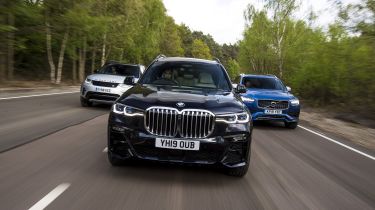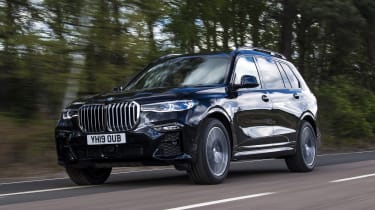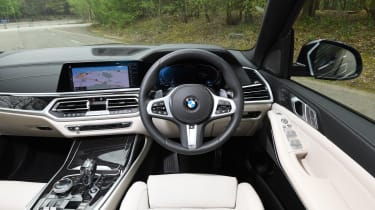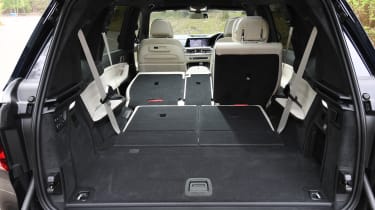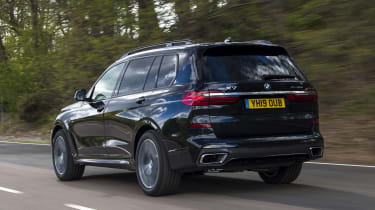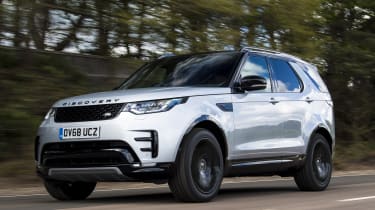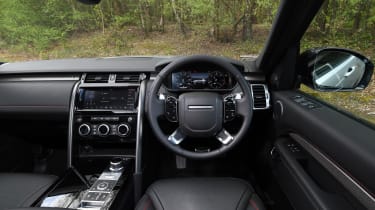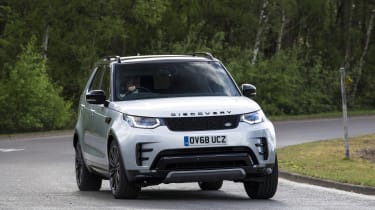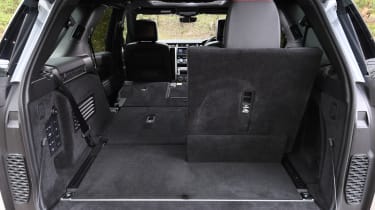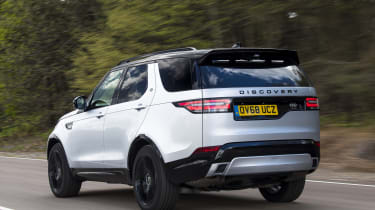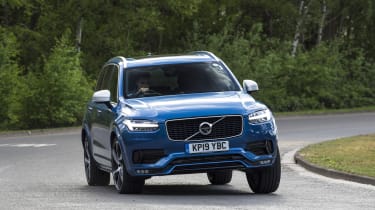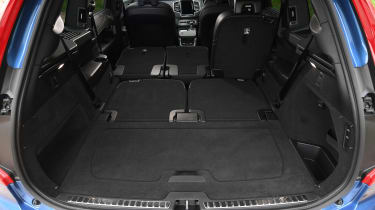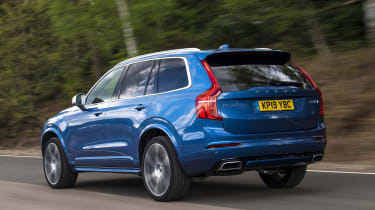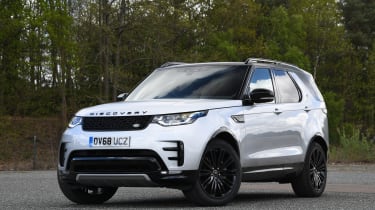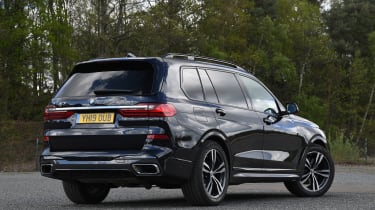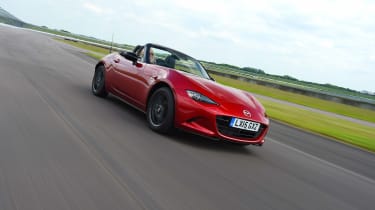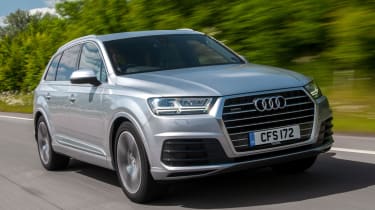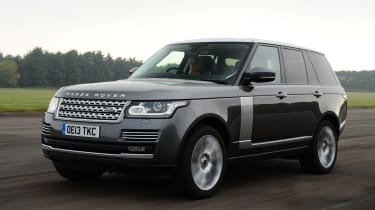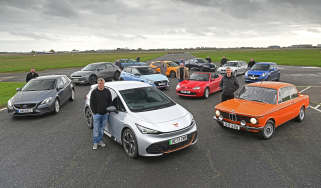BMW X7 vs Land Rover Discovery vs Volvo XC90
The new X7 is BMW's most premium SUV, but is it a match for the Land Rover Discovery and Volvo XC90?
The new BMW X7 is the largest car the firm has built, in search of a slice of the luxury SUV class. While the seven-seater might have been designed to appeal to buyers in the huge and lucrative Chinese and US markets, where premium brands and very big cars are popular and profitable, there are lots of UK customers looking for a large, luxury BMW off-roader, too.
The X7 combines these important factors, but does it make sense in this country? To find out, we’ve brought it together with a key rival in this upmarket class, the Land Rover Discovery, and an alternative to diesel power, the Volvo XC90 T8 plug-in hybrid.
The Discovery is closely matched to the X7 when it comes to practicality, equipment and luxury, having been pushed even further upmarket by the British manufacturer. It’s also one of our favourite premium seven seaters, so it’s the car the BMW has to beat in this group test. But many British motorists are considering a move away from diesel power, which is where the electrified XC90 T8 comes in.
With its plug-in powertrain, the Volvo offers customers the chance to cut their running costs without having to compromise on luxury.
Used - available now
If you’re looking for a premium SUV with space for seven people, each of these models is sure to hold some appeal.
BMW X7
| Model: | BMW X7 xDrive30d M Sport |
| Price: | £74,695 |
| Engine: | 3.0-litre 6cyl diesel, 261bhp |
| 0-60mph: | 6.7 seconds |
| Test economy: | 33.3mpg/7.3mpl |
| CO2: | 171g/km |
| Annual road tax: | £450 |
The X7 sits above the X5 in BMW’s wide-ranging SUV line-up, and here we’re testing the xDrive30d diesel model. It’s the ‘entry-level’ engine, and in M Sport trim, as tested, it costs £74,695.
Design & engineering
BMW’s CLAR platform provides the X7’s base, so some elements are shared with models such as the X5 and 5 Series saloon. The 7 in the name hints at a family link with the 7 Series saloon, so the firm has focused on boosting luxury in order to match its flagship limousine.
Height-adjustable air suspension is fitted as standard; this means the car can be lowered to help with access and to improve aerodynamics, and lifted up to increase ground clearance. It’s four-wheel drive, like both rivals, so it can go off the beaten track, but there’s much less focus on its ability here than in the Land Rover. You can specify a £2,595 xOffroad package, which adds rough-terrain driving modes, a mechanical differential lock and a sump guard.
Under the bonnet there’s a 261bhp 3.0-litre straight-six diesel engine, which powers the wheels through an eight-speed automatic transmission.
Interior quality is as impressive as you might expect from a flagship premium SUV. The materials in the cabin look and feel expensive, while build quality is superb, too, even if the design itself is derivative. The Discovery isn’t built as well and the Volvo’s materials look a little cheaper. There’s lots of kit, and M Sport cars have 21-inch alloys, four-zone air-con, a panoramic sunroof, and two 12.3-inch screens for the sat-nav and dials respectively.
Driving
The BMW’s six-cylinder engine is the least powerful here, with 261bhp. The Land Rover’s V6 diesel has 302bhp, while the Volvo’s 2.0-litre petrol is boosted by an electric motor for a total of 385bhp. However, because its torque figure of 620Nm arrives at 2,000rpm, the X7 can compete with its rivals here for performance.
In our 0-60mph tests, it managed a time of 6.7 seconds, which was a second behind the powerful XC90 T8, but 1.1 seconds ahead of the Discovery. It was a similar story from 30-70mph through the gears, where the XC90 came out on top with a 5.1-second time, the BMW was second (6.4 seconds) and the Discovery last (7.0 seconds).
All three of these models are more than quick enough considering their size and weight, though. The X7’s engine adds to the car’s luxury feel because it’s really quiet, yet delivers strong mid-range torque that’s very useful when you’re on the motorway and faster roads. Wind and road noise are very well suppressed in the BMW’s cabin, too.
• BMW X7 review
Comfort is another X7 strong point, because it rides smoothly over pretty much any road surface. It’s softly sprung, though, which means that undulating roads can cause the car to gently pitch and roll. While it’s not uncomfortable, this does result in a bit of unwanted head movement.
It’s the same story when it comes to cornering, because there’s plenty of body roll. It’s not enough to be disconcerting, however, and is to be expected in a huge SUV. In fact, the well-weighted steering, strong engine and plentiful grip mean the X7 is surprisingly nice to drive. The Discovery is as good, though, if not as agile, and both shade the XC90 for engagement.
The BMW’s eight-speed gearbox is excellent, too: it’s smooth and blends its shifts very well in auto mode, yet it’s also responsive when you need it to kick down and doesn’t leave you waiting for the shift. But the huge flexibility from its torque means it doesn’t look to change as soon as you touch the throttle.
Practicality
It's not much of a surprise to find that there’s a huge amount of interior space. Rear-seat legroom is more than enough for tall adults to sit comfortably, and the adjustable seats mean they can find a good seating position as well.
The same goes for the third row of seats to a lesser extent. There’s enough space for adults to sit inside, and it’s not dark or cramped back there like in many seven-seater models. There’s a little more room in the Discovery’s third row, though, with both cars being much larger than the XC90 in this area.
Even with all the seats in place you get a generous 326 litres of boot space, and there are 750 litres with the third row folded. That’s a bit smaller than the Land Rover’s huge 1,137-litre offering, and it even trails the XC90’s 967 litres. Still, the BMW has plenty of space with all the seats down, at 2,120 litres.
Ownership
Our Driver Power 2019 satisfaction survey revealed that BMW owners were less happy with their purchases than Land Rover or Volvo buyers. The brand came 25th overall in the makers’ chart, a poor result that was five places behind Land Rover and 12 positions adrift of Volvo.
With seven airbags, parking sensors, a reversing camera and AEB fitted, safety is good, and although Euro NCAP hasn’t tested the X7 yet, we expect a strong result. It’s a shame blind spot assist isn’t included.
Running costs
Fuel economy won’t be too much of a concern for buyers at this end of the market, but these cars still have to deliver. The X7 averaged 33.3mpg, which means an annual fuel bill of £2,177. That was ahead of the Discovery, at 28.1mpg, resulting in a yearly cost of £2,587.
The XC90 trumped both cars, returning 38.2mpg, which is £1,819 a year. Users who charge up regularly and use the car’s claimed 29-mile all-electric range for short trips might do better. That’s despite its high-power petrol engine, and thanks to new battery tech.
Testers’ notes “Access to the rear seats in the BMW is pretty good, but the electric operation means it can be a bit of a slow process. However, it should be a help if you’re carrying a child.”
Land Rover Discovery
| Model: | Land Rover Discovery 3.0 Sd6 HSE Luxury |
| Price: | £70,760 |
| Engine: | 3.0-litre V6 diesel, 302bhp |
| 0-60mph: | 7.8 seconds |
| Test economy: | 28.1mpg/6.2mpl |
| CO2: | 198g/km |
| Annual road tax: | £450 |
Land Rover’s Discovery is 30 years old in 2019, but it’s as competitive as ever, so the X7 has a tough challenge. We’re testing the top-spec HSE Luxury model in Sd6 form, which costs £70,760.
Design & engineering
For much of its three decades on the road, the Discovery used an body-on-frame construction, but the latest version features an aluminium monocoque and is closely linked to the high-end Range Rover and Range Rover Sport. In fact, with this fifth generation of the Discovery, Land Rover pushed its seven-seater even closer to the flagship Range Rover, so it’s a natural competitor for the BMW.
Electronically controlled air suspension is fitted as standard, just like on the X7, which helps with on-road manners as well as off-road prowess. Its strength over rough terrain is the Discovery’s unique selling point, and there’s no doubt that this is one of the most capable off-roaders around.
The car’s suspension set-up is automatically altered to adapt to different types of surface using Land Rover’s Terrain Response 2 technology, which is fitted as standard on HSE Luxury models. There are settings for general driving, sand, grass, gravel, snow, rocks and mud ruts – and further technology including hill descent control, wade sensing, low-range gearbox modes and active locking differentials (£1,020) help put the Land Rover top of its class in this regard. Specially placed cameras and sensors mean that even novice drivers can make the most of its ability, too.
Interior quality is strong, although the standard of the build is a little behind its rivals here. The HSE Luxury is as upmarket as its name suggests, though, with 21-inch alloy wheels, four-zone climate control, a Meridian stereo system, heated front and second-row seats and a heated steering wheel. There’s also a digital dashboard and Land Rover’s latest 10-inch touchscreen infotainment set-up.
Driving
The Land Rover’s ability off road is unmatched, but it’s also a brilliant road car. The Discovery makes no apologies about being set up for comfort, and doesn’t even feature sporty driving modes; after all, what would be the point? The other cars do offer these settings, but they make little difference, because ultimately these are huge SUVs that are designed to deliver comfort rather than grip and lots of agility.
That’s not to say the Land Rover is missing those attributes; in fact, its body is nearly as well controlled as its rivals’. However, the Discovery smooths out lumps and bumps very well, even on 21-inch alloys, and it does so with less of the boat-like motion in the X7. It’s the most comfortable car here as a result.
Wind and road noise are minimal, too, although the X7 beats the Discovery for refinement. Both models are more comfortable and quieter than the XC90 when travelling at motorway speeds, but the electric operation of the Swedish SUV means it’s almost silent if you’re driving around town.
The V6 diesel engine in the Land Rover is a bit more grumbly than the smooth six-cylinder unit in the BMW and the hybrid set-up in the Volvo, but it has excellent low-range power delivery.
While it was the slowest car in our 0-60mph tests, taking 7.8 seconds, the Discovery was actually faster than the X7 from 50-70mph in sixth, seventh and eighth gears, proving its impressive flexibility. With 700Nm of torque from just 1,500rpm, the V6 engine is strong and never feels overwhelmed by the Discovery’s 2,236kg kerbweight, and the eight-speed gearbox is smooth, so it’s relaxing to drive.
Practicality
The Discovery isn’t quite as big as the X7 on the outside, but it does have more room for passengers – and it boasts a larger boot when it’s used in five-seat mode.
There are 1,137 litres available with the third row folded, or if you have the seats in place then there’s enough room for adults to sit comfortably. The second row has loads of room as well, so the Land Rover is the most practical car of the three models. Access to the third row is about on par with the BMW’s and a bit easier than in the XC90, but it’s still a bit of a climb to get in.
A towing capacity of 3,500kg is a tonne more than its test rivals can manage, which cements the Discovery as one of the most versatile cars around.
Ownership
Land Rover didn’t perform well in our Driver Power 2019 satisfaction survey, finishing 20th overall in the makers’ chart, although BMW was lower in the rankings.
Safety kit is excellent, however, and you get lane-departure warning, a blind-spot monitor with reverse traffic alert and autonomous emergency braking fitted as standard. Euro NCAP awarded the Discovery five stars, matching the XC90’s rating in the crash tests.
Running costs
This is the cheapest model here as a cash buy, and considering the amount of standard kit on offer, that makes the Land Rover look like good value.
All three cars hold their price well, but the Discovery trails slightly – so you’ll lose marginally more over a typical ownership period than with the other cars.
The Land Rover will shed £35,083 over three years or 36,000 miles, according to our experts, and retain 50.4 per cent of its original list price, while the X7 will hold on to 54.5 per cent and drop £34,024. The XC90 loses the least in depreciation, at £33,073, which is 54 per cent of the Volvo’s initial price tag.
Testers’ notes“The Disco’s huge 85-litre tank means a hefty fill-up cost of £113, but it lets you go more than 520 miles between visits to the pumps. The X7 will set you back £106 to fuel and has a cruising range of 587 miles.”
Volvo XC90
| Model: | Volvo XC90 T8 Twin Engine Inscription Pro |
| Price: | £71,945 |
| Engine: | 2.0-litre 4cyl plus electric motor, 385bhp |
| 0-60mph: | 5.7 seconds |
| Test economy: | 38.2mpg/8.4mpl |
| CO2: | 55g/km |
| Annual road tax: | £440 |
The XC90 T8 plug-in hybrid offers buyers an alternative fuel choice in their luxury seven-seat SUV, and at £71,945 in Inscription Pro trim, it’s a match for its diesel-engined rivals in this test. Our pictures show a D5 model, but it’s a T8 we’re testing.
Design & engineering
Volvo has made a commitment to putting a million electrified cars on the road by 2025, and it’s models like the XC90 T8 that will make that possible. It’s a hybrid that you can plug in at home or at work to keep the battery topped up, avoiding heavy use of the engine.
The T8 Twin Engine uses a supercharged and turbocharged 2.0-litre four-cylinder petrol unit with an electric motor and an eight-speed auto box. The electric motor drives the rear axle, so the XC90 does have some off-roading potential with its 4x4 layout, but this isn’t the road-biased SUV’s main focus.
Adaptive dampers and air suspension are fitted as standard in Inscription Pro trim as part of Volvo’s Four-C active chassis set-up, matching its rivals.
It differs in this group test thanks to its hi-tech powertrain, but also because it’s a little smaller than its competitors when it comes to footprint and interior space. Due to its high-quality interior, however, it feels just as upmarket as it ought to at this price. It uses a neat, clean design with a large portrait touchscreen and plush materials.
The Volvo isn’t quite as luxurious as the BMW or Land Rover, although our top-spec Inscription Pro model is very well equipped. It comes with 21-inch alloy wheels, heated leather seats, four-zone climate control, a nine-inch touchscreen infotainment set-up with sat-nav, and a digital instrument cluster.
Driving
A core part of the XC90 T8’s driving experience is the electric motor. It has 86bhp, which complements the petrol engine’s 299bhp output, especially at low revs. As the engine is building speed and getting into its power band, the electric motor fills in with its instant torque (240Nm of it), so the XC90 is really quick off the line. We recorded a time of just 5.7 seconds from 0-60mph, which was more than a second faster than either of its rivals here, despite them having larger engines.
The electric motor also allows for near-silent running at low speed, so driving around town is very relaxed in the XC90, not to mention efficient. However, once the 2.0-litre petrol engine fires up the Volvo’s refinement is eroded compared with the Land Rover and BMW.
Those models’ six-cylinders are smooth and luxurious to use, unlike the four-cylinder here; it’s noisier and relies on a big boost from forced induction to deliver its power, which means the build-up of power is more aggressive, making the XC90 less relaxing to drive. While the transmission is smooth and matches the Land Rover’s in auto mode going up the gears, it doesn’t respond as well as the British model and can sometimes kick down unexpectedly when you need a burst of acceleration.
Air suspension is standard, but because the T8 is laden with heavy batteries, ride comfort isn’t as good as in non-hybrid models – and the larger the wheels you go for (21-inch rims are standard on the T8), the less comfortable it is. It’s the harshest of the three cars here, although body control is good and the Volvo rolls less than its competitors in corners.
The XC90’s well-weighted controls, plus the punchy engine and electric motor combination, mean it’s good to drive, although the BMW balances ride and handling better, and the Discovery’s focus on comfort will be more appealing to customers in this market who aren’t so interested in handlin
Practicality
Despite being slightly smaller than its rivals here, the Volvo is competitive when it comes to boot space. It has 262 litres available with all the seats up, which is more than in the Discovery (258 litres) but less than the X7 (326 litres). Fold the third row and it also has a bit more capacity than the BMW, at 967 litres. So while the XC90 is practical enough, it can’t match the Disco.
However, the Volvo has the least total boot space and, perhaps more importantly, the rearmost seats are pretty small and won’t be of much use for adults. That’s unlike either of its rivals, which have loads of room in every seat. At least the Swedish car’s second row has plenty of leg and headroom, though.
Ownership
Volvo put in a decent showing in our Driver Power 2019 customer satisfaction poll, finishing 13th in the manufacturers’ standings. That’s way ahead of its rivals here; BMW came in 25th and Land Rover 20th.
The Swedish firm set a target of zero deaths in any of its cars by 2020, so there’s lots of safety kit. The XC90 gets autonomous emergency braking, lane-keep assist, run-off-road mitigation and traffic sign recognition. It even managed a 100 per cent rating in the Safety assist category in its Euro NCAP test.
Running costs
If you are looking for a company car, the XC90 is a clear winner. Low CO2 emissions of 55g/km put it in the 16 per cent Benefit-in-Kind (BiK) category, resulting in a tax bill of just £5,462 for higher-rate earners. Both of the other models sit in the 37 per cent range due to their large diesel engines, so the X7 and Discovery will cost £10,857 and £10,196 respectively in tax.
That huge difference shows how much you can save by running a plug-in hybrid as a company car, but as a percentage of its value, it’s perhaps less important than luxury or practicality for buyers of these SUVs.
Testers’ notes “The 11.6kWh battery that’s a crucial part of the XC90’s hybrid system takes four hours to charge from a 10 Amp supply, or you can charge it while you’re on the move using the engine.”
Verdict
First place: Land Rover Discovery
The Discovery badge means a lot to buyers of luxury SUVs, and there’s a good reason why. It’s supremely comfortable and unmatched when it comes to off-road ability, but it’s also one of the most practical cars you can buy and will easily seat seven people in comfort. The Land Rover has the biggest boot and also has more kit in HSE Luxury form – despite being cheaper to buy. Running costs are a little high, though.
Second place: BMW X7
BMW’s first foray into the luxury SUV segment is a success. The X7 is good to drive, comfortable and has nearly as much space inside as the Discovery, while its cabin is of an even higher quality. BMW’s infotainment set-up is brilliant as well, and there’s lots of boot space with all seven seats in place. It loses out to the better-value Land Rover here, but is still a top choice if you’re after a huge, luxurious SUV.
Third place: Volvo XC90
The finishing order here could easily be flipped if you’re a company car buyer, because the efficient XC90 T8 is much cheaper for business users to run. It’s great for those who cover short distances, because you can run in ultra-quiet and low-cost EV mode. The Volvo is slightly outclassed here for luxury, practicality and comfort, though, which is what many buyers will be looking for in this class. But it’s still a great choice.
Also consider...
Model: Audi Q7 50 TDI quattro 286 Black EditionNew price: £68,115Engine: 3.0-litre V6 diesel, 282bhp
The Audi Q7 is a lower-cost option if you’re after a big, premium SUV, so with our budget here you can get into a high-spec Black Edition model. The Q7 is spacious and has a top-quality cabin, but it isn’t as luxurious or as advanced as the Land Rover or BMW.
Model: Range Rover 3.0 SDV6 VogueUsed price: £75,500Engine: 3.0-litre V6 diesel, 271bhp
It's possible to buy a nearly new Range Rover at this budget; we found a few with delivery miles only for around £75,000 in Vogue form with Land Rover’s diesel V6. The Range Rover is more luxurious than the Discovery inside, but it doesn’t have seven seats.
Figures
| BMW X7 xDrive30d M Sport | Land Rover Discovery 3.0 Sd6 HSE Luxury | Volvo XC90 T8 Twin Engine Inscription Pro | |
| On the road price/total as tested | £74,695/£86,475 | £70,760/£77,535 | £71,945/£71,945 |
| Residual value (after 3yrs/36,000) | £40,671/54.5% | £35,677/50.4% | £38,872/54.0% |
| Depreciation | £34,024 | £35,083 | £33,073 |
| Annual tax liability std/higher rate | £5,429/£10,857 | £5,098/£10,196 | £2,731/£5,462 |
| Annual fuel cost (12k/20k miles) | £2,177/£3,628 | £2,587/£4,311 | £1,819/£3,032 |
| Insurance group/quote/road tax cost | TBC/TBC/£450 | 43/£785/£450 | 45/£766/£440 |
| Cost of 1st/2nd/3rd service | £399 (3yrs) | £375/£519/£426 | £330/£560/£330 |
| Length/wheelbase | 5,151/3,105mm | 4,956/2,923mm | 4,953/2,984mm |
| Height/width | 1,805/2,000mm | 1,888/2,073mm | 1,776/2,008mm |
| Engine | 6cyl in-line/2,993cc | V6/2,993cc | 4cyl/1,969cc plus elec |
| Peak power/revs | 261/4,000 bhp/rpm | 302/3,750 bhp/rpm | 385/6,000 bhp/rpm |
| Peak torque/revs | 620/2,000 Nm/rpm | 700/1,500 Nm/rpm | 400/2,200 Nm/rpm |
| Transmission | 8-speed auto/4wd | 8-speed auto/4wd | 8-speed auto/4wd |
| Fuel tank capacity/spare wheel | 80 litres/run-flats | 85 litres/full-size | 70 litres/repair kit |
| Boot capacity (7/5/2-seat modes) | 326/750/2,120 litres | 258/1,137/2,406 litres | 262/967/1,816 litres |
| Kerbweight/payload/towing weight | 2,370/850/2,200kg | 2,236/964/3,500kg | 2,259/721/2,400kg |
| Turning circle | 13 metres | 12.4 metres | 11.9 metres |
| Basic warranty (mileage)/recovery | 3yrs (unlimited)/3yrs | 3yrs (unlimited)/3yrs | 3yrs (60,000)/3yrs |
| Driver Power manufacturer/dealer pos. | 25th/19th* | 20th/28th* | 13th/9th* |
| NCAP: Adult/child/ped./assist/stars | TBC | 90/80/75/73/5 | 97/87/72/100/5 |
| 0-60/30-70mph | 6.7/6.4 secs | 7.8/7.0 secs | 5.7/5.1 secs |
| 30-50mph in 3rd/4th | 2.9/3.4 secs | 2.9/3.4 secs | 2.2 secs |
| 50-70mph in 5th/6th/7th/8th | 4.4/6.2/8.2/16.3 secs | 5.0/5.9/7.5/11.2 secs | 2.9 secs |
| Top speed/rpm at 70mph | 141mph/1,400rpm | 130mph/1,600rpm | 140mph/1,800rpm |
| Braking 70-0/60-0/30-0mph | 54.2/36.1/9.4m | 54.9/36.6/13.5m | 50.8/38.9/10.6m |
| Noise outside/idle/30/70mph | 68/43/59/69dB | 63/44/61/71dB | N/A/42/61/70dB |
| Auto Express econ. (mpg/mpl)/range | 33.3/7.3/587 miles | 28.1/6.2/524 miles | 38.2/8.4/588 miles |
| WLTP combined mpg | 32.8-33.6mpg | 28.3-31.5mpg | 80.7-113.0mpg |
| WLTP combined mpl | 7.2-7.4mpl | 6.2-6.9mpl | 17.8-24.9mpl |
| Actual/claimed CO2/tax bracket | 227/171g/km/37% | 270/198g/km/37% | 171/55g/km/16% |
| Airbags/Isofix/park sensors/camera | Seven/yes/yes/yes | Eight/yes/yes/yes | Seven/yes/yes/yes |
| Auto box/lane-keep/blind spot/AEB | Y/£3,150^/£3,150^/y | Yes/yes/yes/yes | Yes/yes/£500/yes |
| Clim/cruise ctrl/leather/heated seats | Yes/yes/yes/yes | Yes/yes/yes/yes | Yes/yes/yes/yes |
| Metallic/LEDs/keyless/power tailgate | Yes/yes/yes/yes | £850/yes/yes/yes | £700/yes/yes/yes |
| Nav/digital dash/DAB/connected apps | Yes/yes/yes/yes | Yes/yes/yes/yes | Yes/yes/yes/yes |
| Wireless charge/CarPlay/Android Auto | Yes/yes/no | £378/yes/yes | No/£300^^/£300^^ |
